闫新法
1952年8月出生 河南省栾川县 现居郑州1970年9月参加工作1974年5月从事摄影工作至今中国摄影家协会会员
获奖:
2002年 获河南省首届摄影创作 金像奖2006年 获全国突出贡献摄影工作者称号
展览(个展):
2014年 “皇陵·百姓” 法国·巴黎
2013年 “皇陵·百姓” 台北·艺术摄影博览会
2013年 “皇陵·百姓” 大理国际摄影节
2013年 “皇陵·百姓” 全视影像画廊
2012年 “皇陵·百姓” 上海城市艺博会
2011年 “皇陵·百姓” 美国·洛杉矶
2011年 “红 流” 比利时展览
2010年 “红 流” 全视影像画廊
2009年 “红 流” 丽水国际摄影节
2009年 “红 流” 北京798
2008年 “闫新法摄影作品展” 上海全摄影画廊
2007年 “闫新法摄影作品展” 比利时皇家历史艺术博物馆
2007年 “皇陵·百姓” 河南博物院
2007年 “皇陵·百姓” 北京 大众影廊
2006年 “皇陵·百姓” 连州国际摄影节
2005年 “根 脉” 平遥国际摄影节
2000年 “长河星灿” 河南博物院
联展:
2014年 “根 脉” 云南元阳国际摄影节
2014年 “根 脉” 梨面沟艺术部落
2011年 “寻找中国脸谱” 平遥国际摄影节
2011年 “中国当代摄影展” 印度五大城市巡展
2010年 “夏 至”摄影展 上海全摄影画廊
2005年 “根 脉” 河南摄影50年
2002年 “日子扛在肩上” 河南摄影周
1998年 “无声岁月” 河南升达美术馆
1995年 “95 摄影中原” 河南博物院
出版:
2013年 《皇陵·百姓》 郑州
2003年 《根 脉》 北京
1999年 《红流100》 香港
1998年 《生活留言》 香港
1998年 《无声岁月》 香港
收藏
2010年 “皇陵·百姓” 厦门摄影博物馆
2009年 “红流” 全视影像画廊
2009年 “红流” 华辰拍卖
2008年 “守河·杨玘屯” 西班牙瓦纶西亚现代艺术博物馆
2008年 “1993鲁山” 全摄影画廊
2007年 “皇陵·百姓” 华辰拍卖
2006年 “守河” 华辰拍卖
2005年 “根脉” 河南博物院
Yan Xinfa
1952 Born in Luan Chuan (Henan Province)
Since 1974 Photographer, live in Zhengzhou Member of China Photographers Association; Vice-President of Henan Photography Association
2002 First Prize of the First Henan Photography Awards
2005 First Prize of Henan Jin Lu Photography Awards
2006 Outstanding Contributor of the National Photographer Awards
Publications
1998 “Silent Years ” & “Messages For Life” Hongkong
1999 “The Lost Red Army Soldiers”, Hongkong
2003 “The Root”, Beijing
Exhibitions
1995 Photography In China Central 1995, Henan Museum
1996 One Day In Henan, Henan Museum
1998 Silent Years, Sheng Da Gallery
2000 Long River and Shinning Stars, Henan Museum
2002 Carrying life onto the shoulders, Henan Photography Week
2005 The Root, Ping Yao International Photography Festival Yan Xinfa's solo exhibition, Jin Cheng Photography Exhibition The Root, Nationwide Tour ExhibitionFifty years Photography in Henan, Henan Museum
2006 “Imperial Mausoleum & People”, Lianzhou International Photography Festival
2007 “Imperial Mausoleum & People”, Beijing Da Zhong Photography Gallery; Henan Museum; Arles Photography Festival (France)
2007 Yan Xinfa's Phototography Solo Exhibition, Musees royaux d'Art et d'Histoire
2008 Yan Xinfa's Phototography Solo Exhibition, OFOTO Gallery, Shanghai
2009 Yan Xinfa's Phototography Solo Exhibition, EPSITE
2009 Yan Xinfa's Phototography Solo Exhibition, Pan-view Gallery
Collections
“The Root”, Henan Museum, China
“Guarding The River”, Hua Chen Auction, China
“Mausoleum&Common People”, Hua Chen Auction, China
“1993 Lu Shan”, Quan She Ying Gallery, China
“Guarding The River: Yang Qi Tun”, Morden Art Museum, Valencia
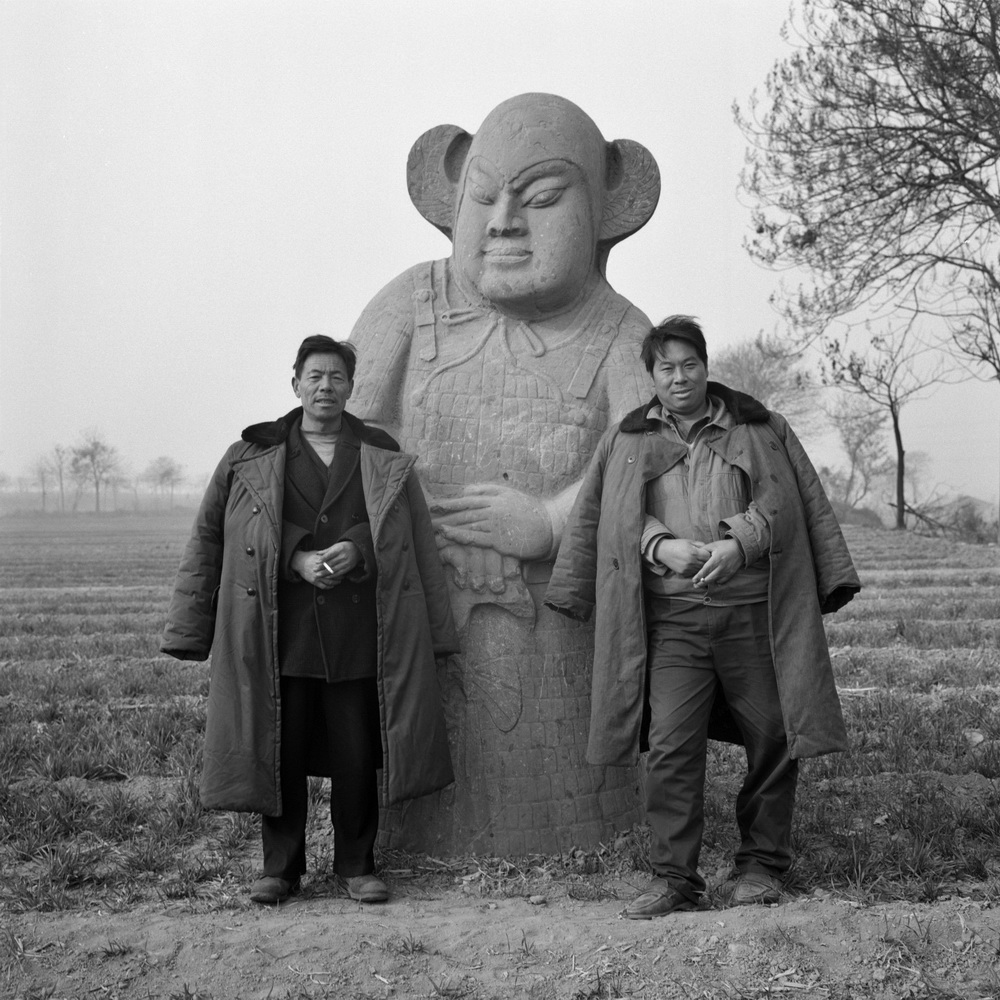
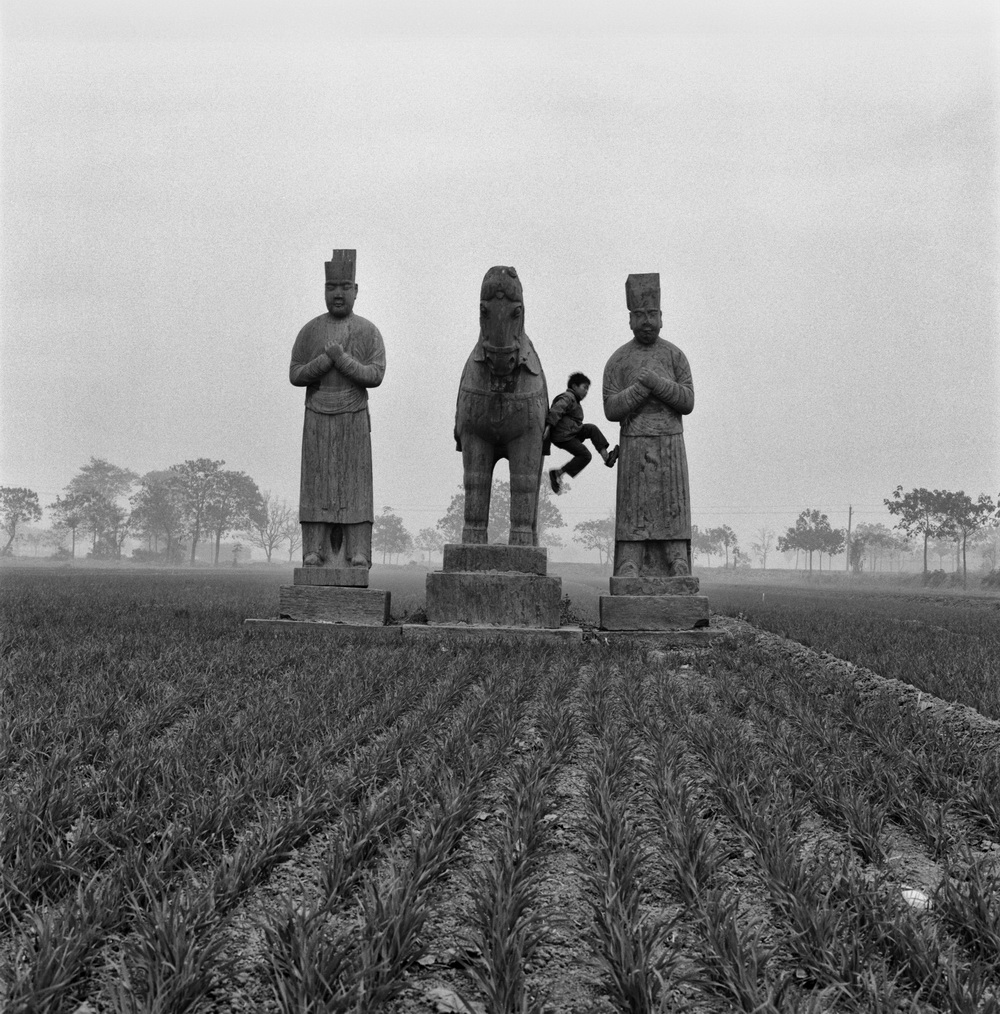
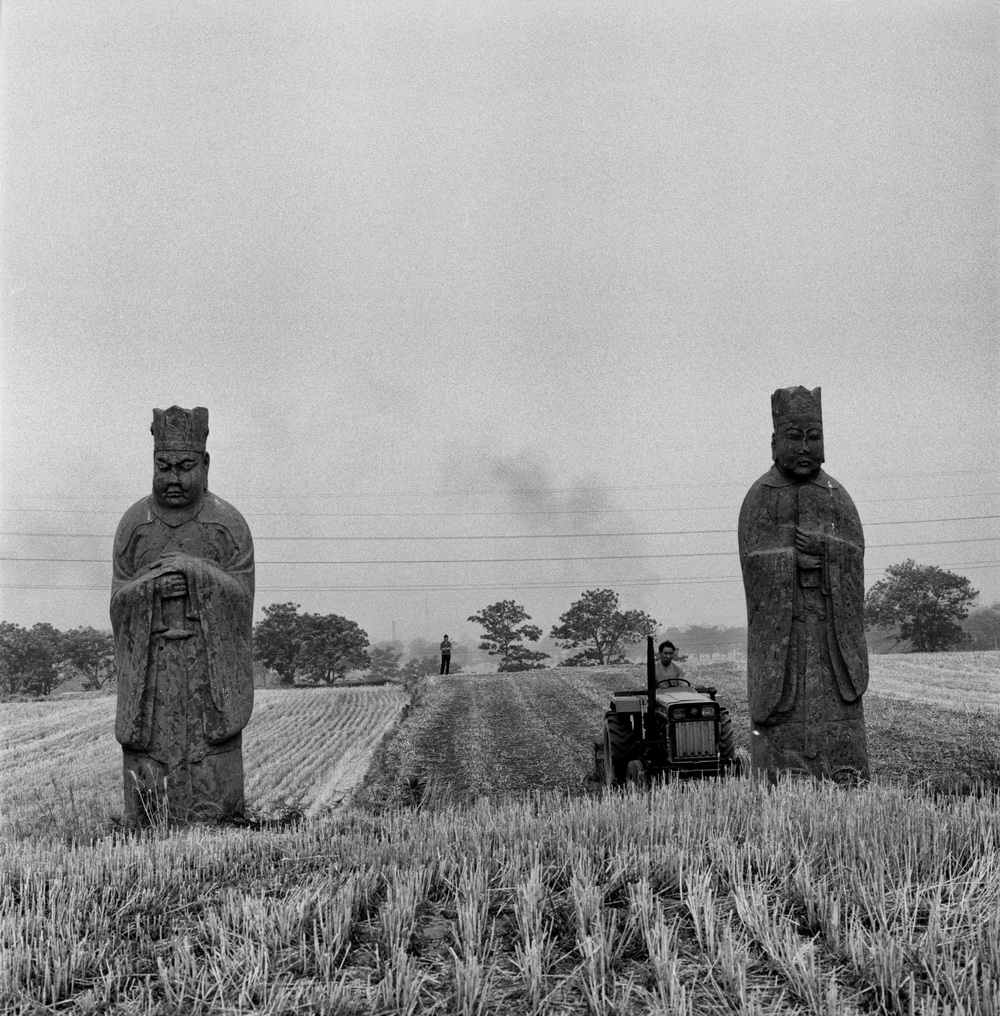

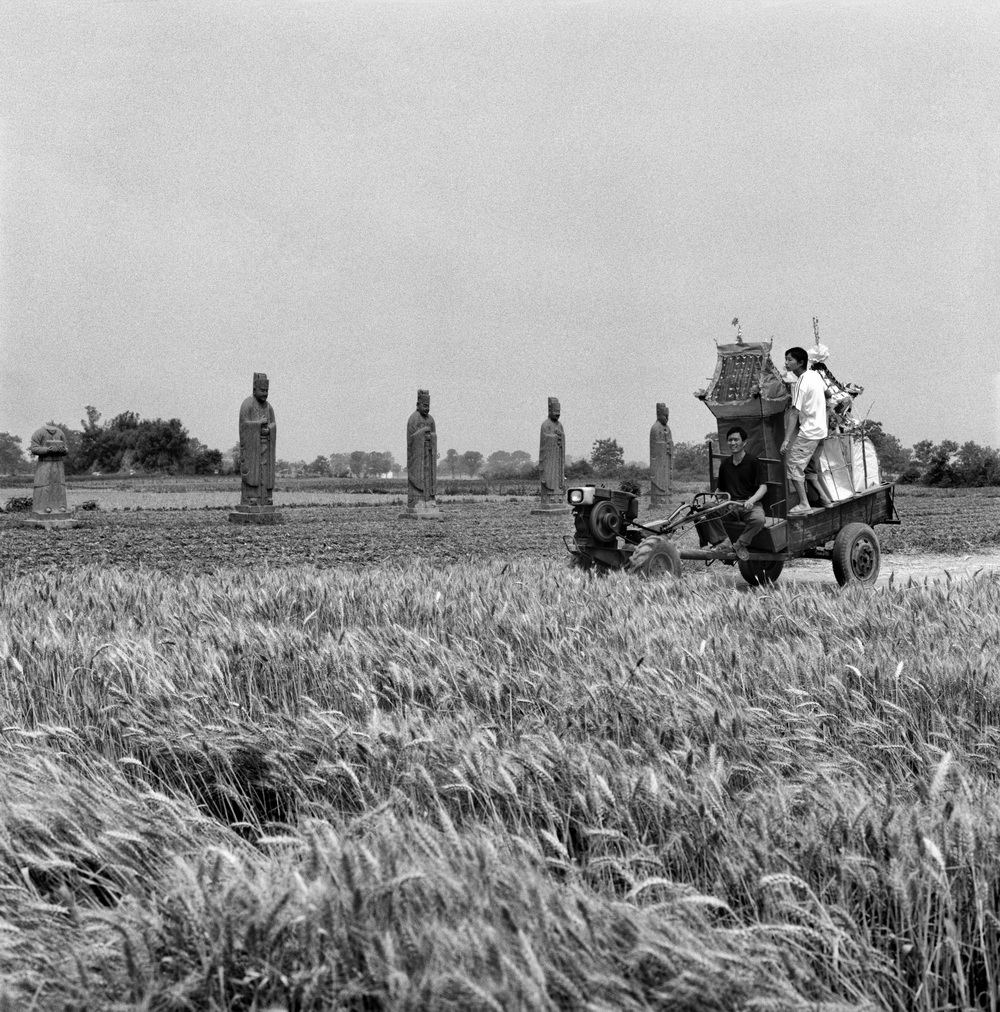
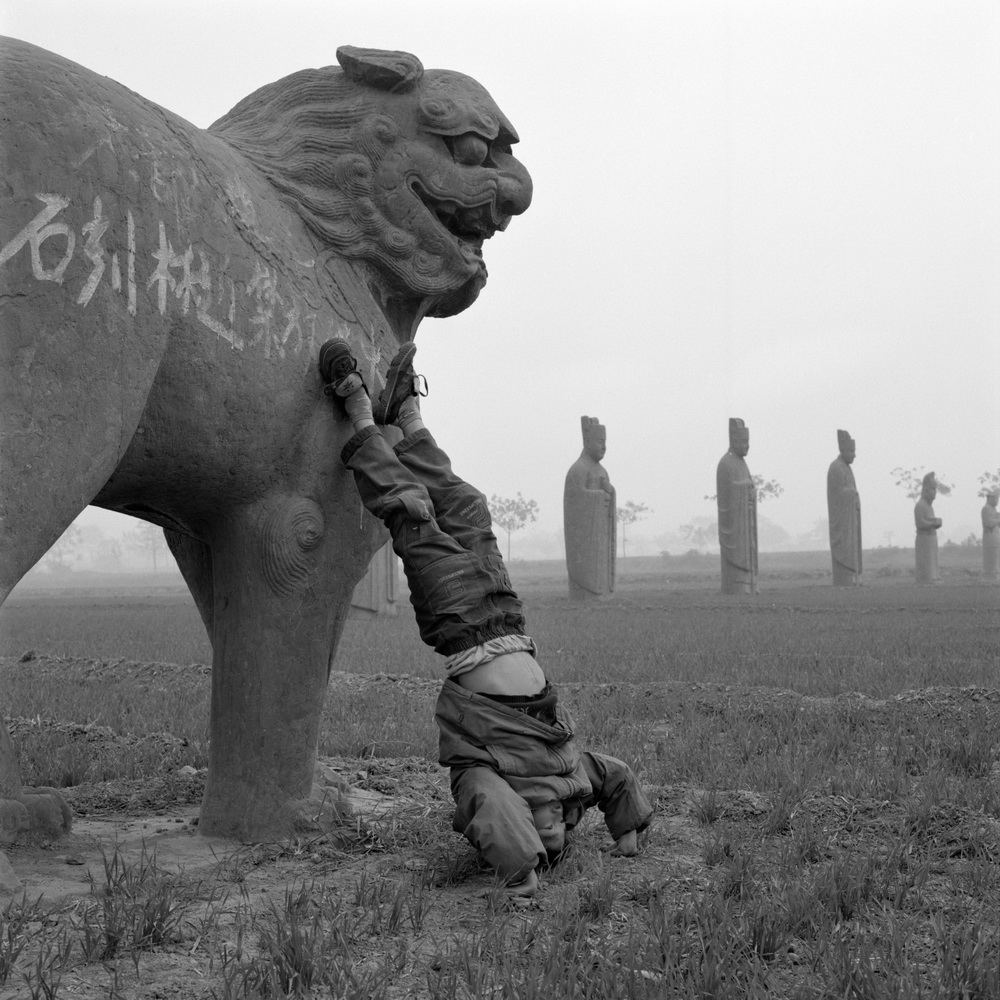
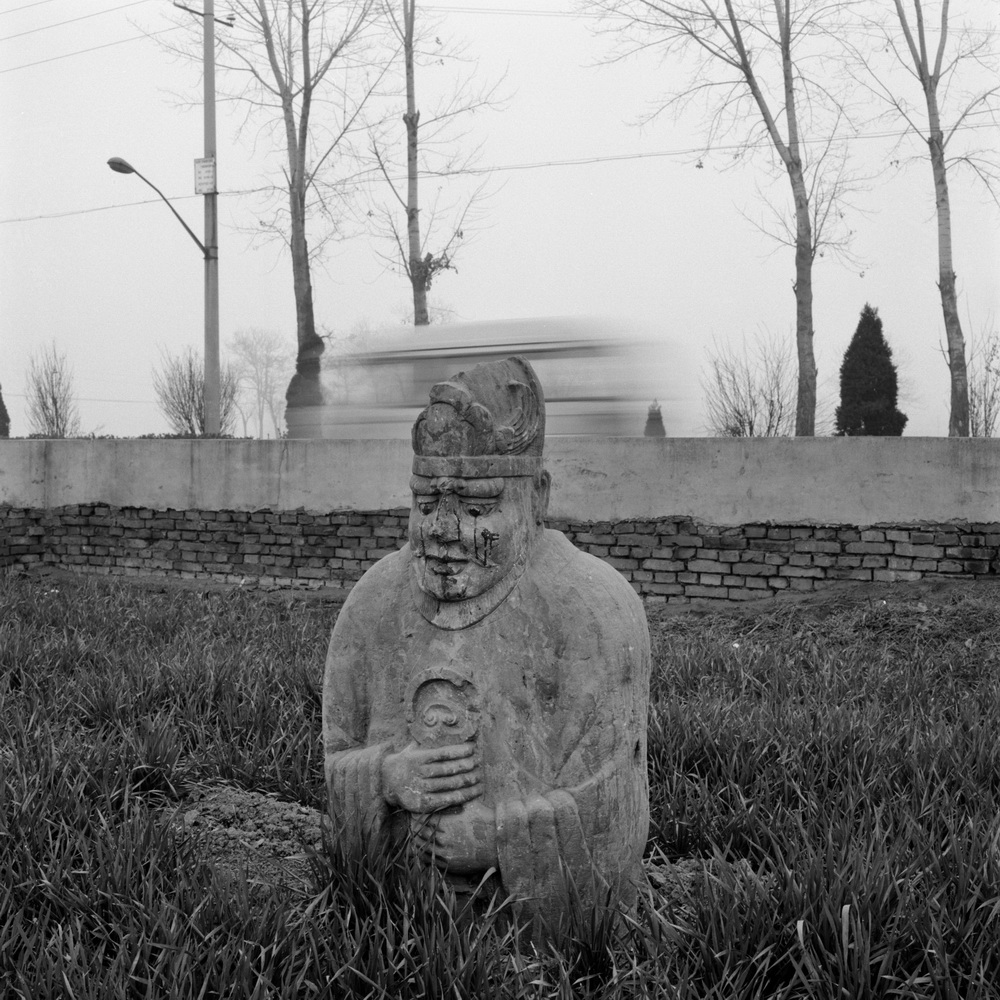
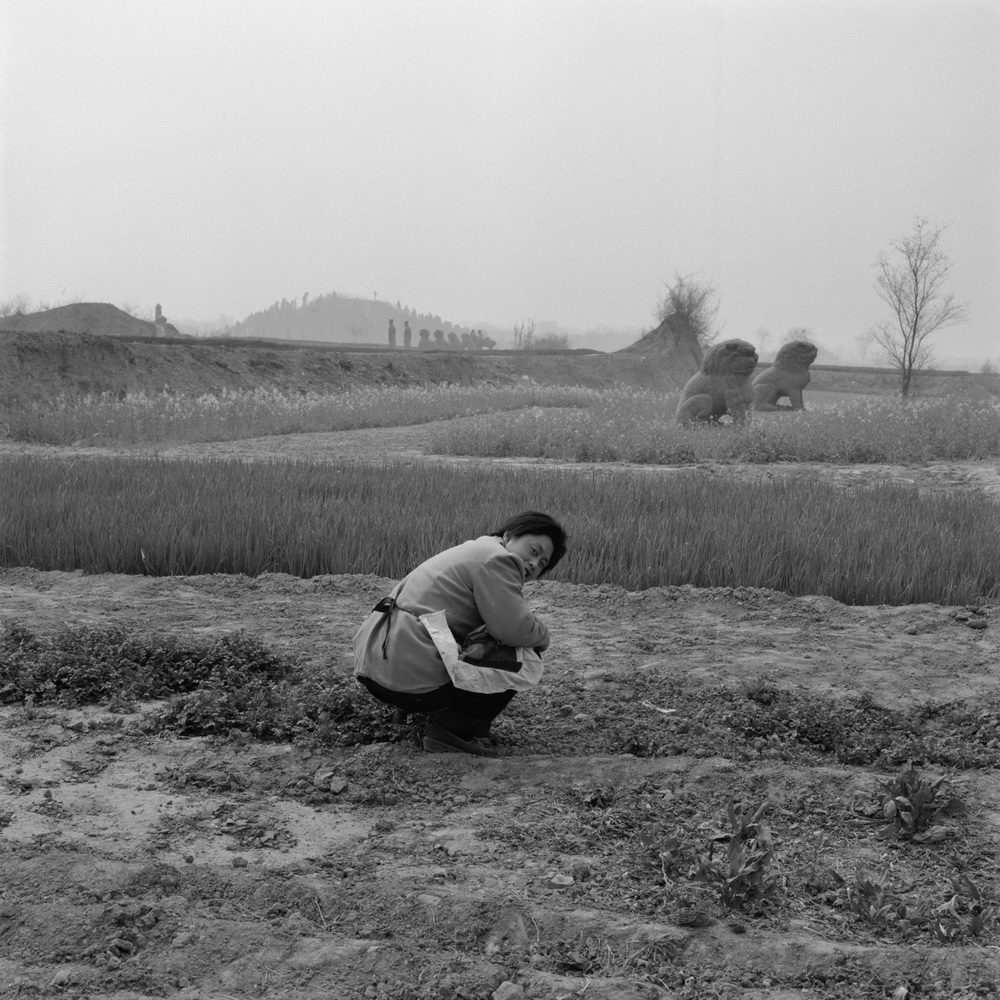
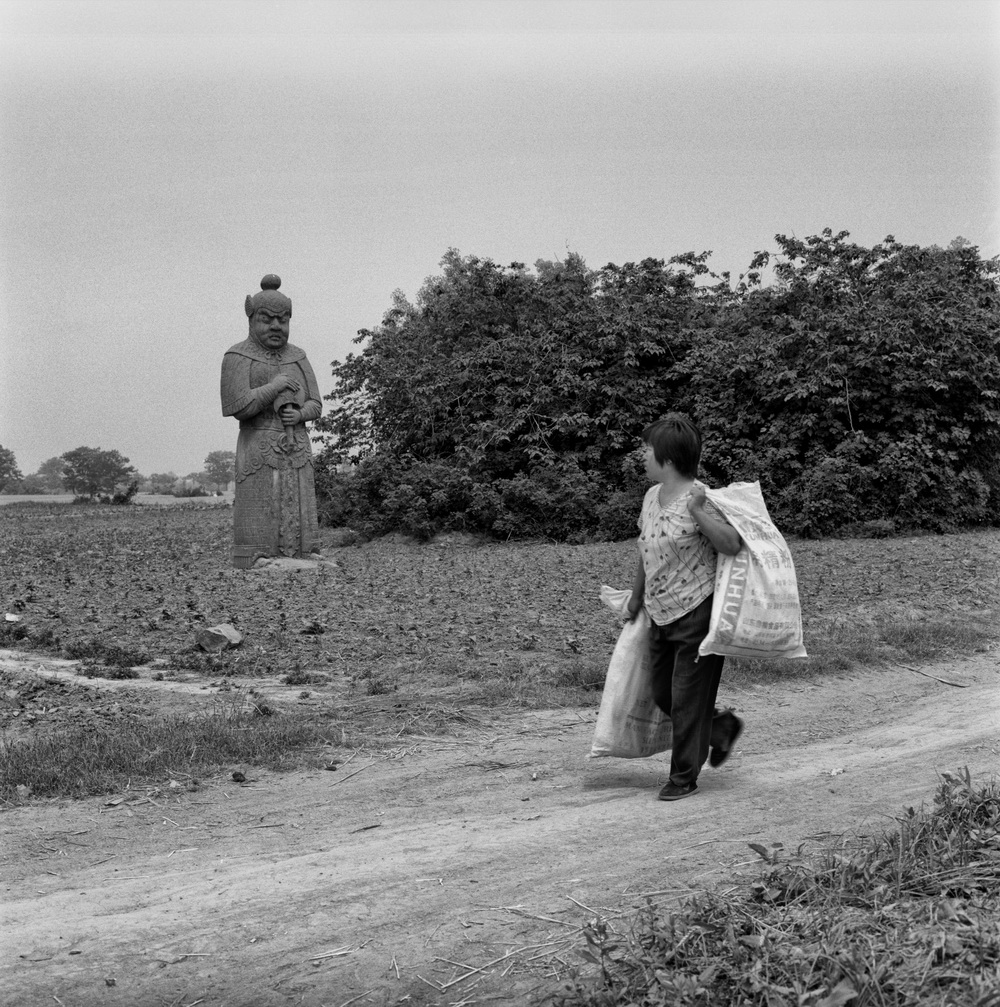
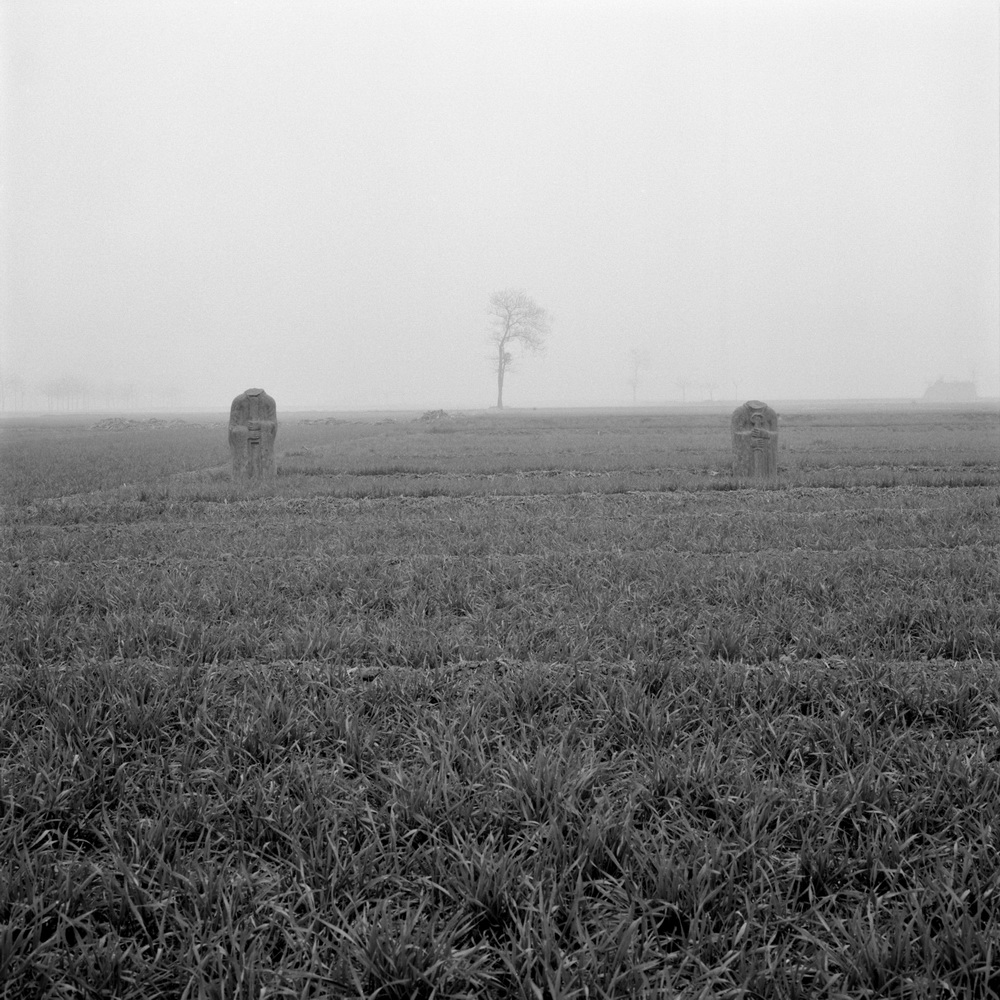
阎新法将许多年来在河南巩义宋陵拍摄的作品集结成册,以一种统一的符号化的方式,将这块土地的岁月断片统一在一种氛围和背景中,以整体的面貌,营造了略感冷清与静默的存在于历史表征中的现实情景。在这些情景中,我们通常对于人的伟大与现实的强硬的认知,在历史语境中尽显渺小。世世代代芸芸众生,谁不是早早地就沉入那些雕像足下的泥土?尽管四季变化,种了,收了,又种了又收了,生命生生不息。唯有那些亘古不变的表情、姿态,归纳了全地的喧哗与躁动。希望永生的帝王归于尘土,留下那些雕像证明自己的徒劳。肉身怎样也没能较量过大自然的一块石头。去了,来了,又去了又来了……
无论哪个朝代,土地上的人们就是如此活着,与其说土地陪伴着人,不如说人以活着的耐心陪伴土地。虽然我们号称中国农村这些年发生了翻天覆地的变化,然而只要土地不变,所有的变化不过烟云过眼。无论多么的辉煌,以及多么顽强地挣扎在与自然规律的抗衡中,最终,都强不过上帝的规定,尘归尘,土归土。帝王如此, 百姓如此。不同的是,帝王有我们眼前看到的这些石头的雕像,而百姓,则完全地溶入地土。看新法的照片,时会突然感觉穿越千年,人与土地共同保持的那份平静,有一种超现实的存在感。因此,我宁愿把新法的图像看作是历史的现场。这是由于所有图片中强烈而重复的符号特征强加给我们的。新法努力地让历史变得具体,变得鲜活,并且无处不在。他不断地提示着我们,那些在时间深处埋藏的,并不会真正的沉寂。那些被现实抛弃的,并不等于消逝。历史,需要永远地活在当下的现实之中,人,永远地需要保留对于历史的依赖或者是联系。我想,这是新法希望表达的历史观。
从另外一面,我们又看到了在历史语境中,与当下生活经验完全不同的现实面貌。新法图像中的现实场景在与历史共生的相处中,显现出一种平安的归属感。几乎每一张照片中的情景,都实在地远离了躁动与喧闹,体现出归顺土地的平静。人之所以心生不安惧怕,之所以欲望膨胀,都是因为不愿把自己看作是自然的一部分。大自然中,谁会在乎一簇鲜花的枯荣?满地的落叶,又有哪一片会抱怨哀叹?!自知是自然的一部分,荣了,枯了,顺其自然。我似乎感觉新法希望在他的图像中进行着一种顺其自然的努力,质朴地依着生命的本性,从现实后退。他用对于图像的空间经营,给了我们一种实在的,与当下保持距离的维度。这是新法希望表达的现实观。
河南是一个随处一跺脚,就会惊动几千年地土的地方。而新法恰恰是河南历史博物院拍摄文物的专职摄影师。几十年来,成天注目的是几千年前的珍贵物件。就凭这浸淫于时间长河中的触摸与凝视,一种深厚的历史灵性相信已经渗进他的精神城池。甚至他的相貌竟然也与宋陵武士石雕像酷似。其实也说不准,新法就是他们一脉相承的后裔。从新法的摄影,我们强烈地感受到职业对于他的影响,他总是自觉不自觉地靠向历史,他有一种顺服于广袤中原地土的态度,他一直行进在历史与现实的交错中。这一切形成了他在河南摄影群体中独特的面貌与位置。
我非常羡慕生活在河南的摄影家,他们真是非常的庆幸。他们在历史无所不在的巨大笼罩之下寻找和确定自己的位置,他们举起相机就与历史相遇,并且在这种相遇中形成自己独特的摄影观看。在这样的摄影环境中人多不会轻浮,因为他们知道努力,敬畏地土。
在大海的深处
记得最早看到闫新法的作品,是一组农村小景:起伏于山坡的小路,枝杈弯曲的老树,还有不少村头或庭院的石头墙……。画面非常平实,但能使你的目光马上变得温和起来,细细地感受不断飘出的乡风乡情。后来看到的大都是人物了,但这种最初的感觉依然存在。他的人物总透出一种平和安详,他的乡村散发着淳朴与温馨。没有大喜大悲的热闹,没有有声有色的渲染,也没有多少当代社会变化的标记,只有一个个平和安详的农民,一座座淳朴温馨的村落,一种没有任何强加于包装的平实生活。我觉得这是一种“剥离”,他把农村从现实的纷杂中孤立出来,剥去未经时间沉淀的浮层,来得到一个比较纯粹的“原生态”。这种剥离又恰是他进入的方式,他通过一个个富于历史感的“原生态”的乡村,顺畅的进入到对中原历史文化的抚摸与体味。
阎新法始终以平和的心态关注着中原乡村的百姓生活,他的作品没有刻意的煽情,没有强烈的视觉营造,在平静朴实的视点中记录着乡间寻常的日子,还原着这片土地的本来,因为在他的眼里这“本来”中就蕴藏着民族的根脉,历史的传承。他潜入其中,细细体味,身心也与这“本来”糅合在一起。他镜头里的“中原农村”,从对象意义上可以说是一个“文化标本”,从主体角度上说则是他的“精神家园”。因此我们会在这些鲜活的民生样态中感觉到时间沉积、文脉绵延,土地、民族、文化、历史的情愫在温和朴拙的乡风中飘逸而出,也能体会到一种深切的精神认同感和归属感。
一年冬季的一天,闫新法独自一人徜徉在豫西黄河岸边的一个小村庄,这里人去室空,满眼断壁残垣。因为建设黄河小浪底工程,全村已迁往别处。他久久地注视着卸去门窗的窑洞,院里遗弃的石墩,墙上斑驳的贴画,想象着这里曾经有过的生活和可能发生的故事。想到一年以后眼前的一切将淹没到小浪底水库数十米以下,不禁发出深深地叹息,用相机拍下了这个村落最后的一幕。闫新法是听说这个村庄后专程赶来的,他的这次拍摄成为对一个最新的“文化遗址”的凭吊。他曾说过:中国历史文化就是农民文化,农民是历史文化的创造者、承载着和体现者,而中原是中国历史的文化的发祥地和集中代表。数十年的拍摄,他与农民的血脉已经贯通,情感已经交融,心智已经合一。他的精神世界始终处在或者说他实际生活在一种“历史情境”中,对于漂浮在生活表面花里胡哨的东西他不屑一顾,对未经历史沉淀的事物他没有热情,对于别人的选择他无意评说。如果说生活是一片浩瀚的大海,他不理会海面上风云激荡,波翻浪涌,而是悄悄潜入大海深处,感受着大海的温度,品味着大海的蕴藏,接受着大海的浸润,最终自己也融进了大海。大海深处才是他的精神家园。他非常乐意承认自己现在就是一个农民。
阎新法朴实平和,从不强求什么,拍摄就像乡民们一样的日常生活,从容坦然,无染无着;又执著认真,卅载只身孤旅,目标认定便不游移。影像的平实质朴、意味绵长与其说是他风格,不如说是他的态度、他的性格。这些中原乡村的图像展开着一个摄影家的生命现实,也呈现出一个坚守者的姿态。
闫新法说他庆幸自己找到了摄影这种“诉说方式”。把摄影内化为一种自己的诉说方式,其实是一个很高的境界,可能有的人一辈子也达不到这样的境界,闫新法似乎不经意地达到了。或许应了那句禅宗偈语:人人皆有佛性,寻佛则佛不在。忽然间又想到:值得闫新法庆幸的,究竟是他找到了摄影这种诉说方式,还是这种方式给了他一个长相厮守的精神家园。
Through the Historical Sites
Yan Xinfa compiled his photographic artwork about Mausoleum of Song Dynasty that he has been shot for many years into a book collection, in a unified form of symbolism, linking the historical fragments about this land into a kind of environment and backdrop. The entire visage creates a somewhat lonely and tranquil realistic circumstance existing in historical characterizations. In such scenes, our usual concept of man’s grandness and reality’s rigidness is turned into tininess in these historical contexts. Generation after generation, can any living creature escape the fate to hastily descend to the dirt at the foot of statues? Even though seasons came and went along with sowing, harvesting, sowing again and harvesting once again.. Lives circle on and on. Only the eternally immutable expressions and postures concluded all the tumults and fidgets. Emperors dreaming of immortality returned to earth only to leave the statues proving their unavailability. A piece of stone from nature just beats any fleshes. Gone, came, gone again and came once more…
No matter in which dynasty, the people of the land keep living this way. Rather than the land accompanies man, people lives with land patiently. Even if we claimed our countryside has taken a grand new look these years, yet all the changes will be gone with the wind if the land stays unchanged. No matter how brilliant, how doggedly contend with tenaciously struggling against the natural law, in the end, no one could escape the power of the God. Earth to be earth and dust to be dust. Emperors or commons made no difference; the only difference is that what the former left behind is these stone statues while the latter completely melted to earth. While appreciating Yan’s pictures, sometimes you would have a sudden illusion to pass through the millenniums. The peace maintained by man and earth turns a surrealistic existing. Therefore, I would rather regard Yan’s photos as the historical scenes, which were imposed on us by strong and repeated symbolic features from all the pictures. He tried to make history concrete and specific, enlivening and ubiquitous. He kept reminding us: those buried deep in time will not be quiescent. Those discarded by reality do not mean withering away. History needs living forever in the present. Man needs to keep relying on or linking to history eternally. I presume this might be the history perspective Xinfa hopes to express.
From another aspect, from the historical context, we can decode a stark, realistic visage totally different from our present life experiences. The realistic scenes in his images reveal a sort of sense of belonging in peace coexisting with history. Almost any spot in each of his picture is truly far away from boisterousness, noise and excitement and shows the tranquility returning to earth. The reason why a man feels upset and fearful, why man’s desires are so exaggeratedly swelled up are all because man regards itself alien of the nature. In nature, who takes care of a withering flower and who wails or grumbles for the fallen leaves on the ground?! Knowing as one part and belong to the nature, let it take its course flourishing or withering. I somewhat feel that all through his images Xinfa hopes to conduct an endeavor to suit the nature, to rely naively on life’s inherent quality and to step back from reality. By managing spaces in his images, he gives us a solid dimension some distance away from the present. This is Xinfa’s perspective about the reality he wants to express.
Henan is such a place where one casual stamp will make thousand-year-old land a start. Xinfa has been just a professional photographer in Henan Museum. For many decades, he has been gazing all day at those valuable ancient relicts. Immersed in time river by touching and gazing, a hefty historical intelligence has been deeply sedimented in his spiritual city moat. Even his appearance takes much similarity in the face of warrior statues in the Song Mausoleum. In fact, maybe Xinfa himself is the offspring immediately down from the continuous line of the warrior. From his photos we immensely feel the impact to him by the profession. Xinfa kept leaning on history involuntarily and resorting to the vast Zhongyuan field. He is always marching at the cross points of presence and history, which has formed a unique feature and position among the photographic group in Henan.
Very much I envy photographers living in Henan. How lucky they all are looking for and locate their positions in the ubiquitous and immense historical environment. Lifting camera they will come across history and in this encountering, they form their special photographic images and perspectives. In such photographic environment, people are seldom frivolous since they are in awe of earth and clear to strive.
In the deep Ocean
Few people could like Yan Xinfa, who traveled through the every corner of Henan province, one after another village in the past 30 years, and remained in his own designated area of photography. He was clinging to his central rural countryside devotion, formed his own viewpoint, found his spiritual home, and formed its own unique temperament of images.
Remember the first time when I saw the Yan’s work, is a set of rural scene: up and down hills, bending branches old trees, and many stone walls at the entrance or the courtyard of the village, etc. The picture is quite plain, but it makes your eyes immediately become soft, and deeply feel nostalgia constantly coming out with the wind. Most to see later are people, but the initial feeling is still there. In his pictures, characters are always peaceful and serene; the counties are always with real and sweet. No big boisterousness, no color rendering, and no marks of social changes, there are only gentle and peaceful farmers, sweet and simple villages, a kind of plain life. I think it is a kind of "peeling off", he isolates the rural life from the reality, peels off the distracting layers, to get the "origin", thus smoothly enters into the central plains culture and history. Yan Xinfa always focus on rural folk life in the central plains area with his gentle state of mind. His work has no deliberate sensation or visual building, but restore the truth of ordinary days in the countryside. In Yan’s eyes, the land is rooted from the culture of the nation and continues the history. He makes himself close to the land, as he considers blending himself into its surroundings. He believes that ‘the land’ is a spiritual home.
One day during a winter, Yan Xinfa wandered alone the in a small village which is empty. The entire village has forced to relocate to somewhere else because of the Xiaolangdi Dam Project nearby the Yellow River. He heard of the story and came all the way to this place, and used his camera to record images for the final scene of the village. Later, his photographs became the last visual proof for the new “national heritage site.”
Yan once said, peasant culture is the core of China’ culture, peasants are the creator, carrier, and embodier of modern Chinese culture and history. Additionally, the Central plains are the place where the history happened. More than years of shooting images about the place, Yan Xinfa became closely connected with peasants and their land. He lives in a “historical context,” and has no passion about other photography contexts. If our life is the ocean, he is the one diving into the deep ocean without being satisfied with playing with the waves. The deepest place of ocean is the spiritual home he is always looking for. He is pleased to say he is now a true peasant.
He is gentle and modest, and believes that taking photos is part of his life; he lives with calm, treats life seriously, and travels alone. The photographic work reveals the real life gesture of a real photographer and makes us think. He said he’s lucky to find his way of narrative—use photography as a tool to speak out for himself; and reach a higher realm of life that not everyone is able to pursue. It should be that sentence: We all have a pure and clear Buddha nature, obscured by worry and delusion.
1952年8月出生 河南省栾川县 现居郑州1970年9月参加工作1974年5月从事摄影工作至今中国摄影家协会会员
获奖:
2002年 获河南省首届摄影创作 金像奖2006年 获全国突出贡献摄影工作者称号
展览(个展):
2014年 “皇陵·百姓” 法国·巴黎
2013年 “皇陵·百姓” 台北·艺术摄影博览会
2013年 “皇陵·百姓” 大理国际摄影节
2013年 “皇陵·百姓” 全视影像画廊
2012年 “皇陵·百姓” 上海城市艺博会
2011年 “皇陵·百姓” 美国·洛杉矶
2011年 “红 流” 比利时展览
2010年 “红 流” 全视影像画廊
2009年 “红 流” 丽水国际摄影节
2009年 “红 流” 北京798
2008年 “闫新法摄影作品展” 上海全摄影画廊
2007年 “闫新法摄影作品展” 比利时皇家历史艺术博物馆
2007年 “皇陵·百姓” 河南博物院
2007年 “皇陵·百姓” 北京 大众影廊
2006年 “皇陵·百姓” 连州国际摄影节
2005年 “根 脉” 平遥国际摄影节
2000年 “长河星灿” 河南博物院
联展:
2014年 “根 脉” 云南元阳国际摄影节
2014年 “根 脉” 梨面沟艺术部落
2011年 “寻找中国脸谱” 平遥国际摄影节
2011年 “中国当代摄影展” 印度五大城市巡展
2010年 “夏 至”摄影展 上海全摄影画廊
2005年 “根 脉” 河南摄影50年
2002年 “日子扛在肩上” 河南摄影周
1998年 “无声岁月” 河南升达美术馆
1995年 “95 摄影中原” 河南博物院
出版:
2013年 《皇陵·百姓》 郑州
2003年 《根 脉》 北京
1999年 《红流100》 香港
1998年 《生活留言》 香港
1998年 《无声岁月》 香港
收藏
2010年 “皇陵·百姓” 厦门摄影博物馆
2009年 “红流” 全视影像画廊
2009年 “红流” 华辰拍卖
2008年 “守河·杨玘屯” 西班牙瓦纶西亚现代艺术博物馆
2008年 “1993鲁山” 全摄影画廊
2007年 “皇陵·百姓” 华辰拍卖
2006年 “守河” 华辰拍卖
2005年 “根脉” 河南博物院
Yan Xinfa
1952 Born in Luan Chuan (Henan Province)
Since 1974 Photographer, live in Zhengzhou Member of China Photographers Association; Vice-President of Henan Photography Association
2002 First Prize of the First Henan Photography Awards
2005 First Prize of Henan Jin Lu Photography Awards
2006 Outstanding Contributor of the National Photographer Awards
Publications
1998 “Silent Years ” & “Messages For Life” Hongkong
1999 “The Lost Red Army Soldiers”, Hongkong
2003 “The Root”, Beijing
Exhibitions
1995 Photography In China Central 1995, Henan Museum
1996 One Day In Henan, Henan Museum
1998 Silent Years, Sheng Da Gallery
2000 Long River and Shinning Stars, Henan Museum
2002 Carrying life onto the shoulders, Henan Photography Week
2005 The Root, Ping Yao International Photography Festival Yan Xinfa's solo exhibition, Jin Cheng Photography Exhibition The Root, Nationwide Tour ExhibitionFifty years Photography in Henan, Henan Museum
2006 “Imperial Mausoleum & People”, Lianzhou International Photography Festival
2007 “Imperial Mausoleum & People”, Beijing Da Zhong Photography Gallery; Henan Museum; Arles Photography Festival (France)
2007 Yan Xinfa's Phototography Solo Exhibition, Musees royaux d'Art et d'Histoire
2008 Yan Xinfa's Phototography Solo Exhibition, OFOTO Gallery, Shanghai
2009 Yan Xinfa's Phototography Solo Exhibition, EPSITE
2009 Yan Xinfa's Phototography Solo Exhibition, Pan-view Gallery
Collections
“The Root”, Henan Museum, China
“Guarding The River”, Hua Chen Auction, China
“Mausoleum&Common People”, Hua Chen Auction, China
“1993 Lu Shan”, Quan She Ying Gallery, China
“Guarding The River: Yang Qi Tun”, Morden Art Museum, Valencia










穿行在历史现场
李 媚
阎新法将许多年来在河南巩义宋陵拍摄的作品集结成册,以一种统一的符号化的方式,将这块土地的岁月断片统一在一种氛围和背景中,以整体的面貌,营造了略感冷清与静默的存在于历史表征中的现实情景。在这些情景中,我们通常对于人的伟大与现实的强硬的认知,在历史语境中尽显渺小。世世代代芸芸众生,谁不是早早地就沉入那些雕像足下的泥土?尽管四季变化,种了,收了,又种了又收了,生命生生不息。唯有那些亘古不变的表情、姿态,归纳了全地的喧哗与躁动。希望永生的帝王归于尘土,留下那些雕像证明自己的徒劳。肉身怎样也没能较量过大自然的一块石头。去了,来了,又去了又来了……
无论哪个朝代,土地上的人们就是如此活着,与其说土地陪伴着人,不如说人以活着的耐心陪伴土地。虽然我们号称中国农村这些年发生了翻天覆地的变化,然而只要土地不变,所有的变化不过烟云过眼。无论多么的辉煌,以及多么顽强地挣扎在与自然规律的抗衡中,最终,都强不过上帝的规定,尘归尘,土归土。帝王如此, 百姓如此。不同的是,帝王有我们眼前看到的这些石头的雕像,而百姓,则完全地溶入地土。看新法的照片,时会突然感觉穿越千年,人与土地共同保持的那份平静,有一种超现实的存在感。因此,我宁愿把新法的图像看作是历史的现场。这是由于所有图片中强烈而重复的符号特征强加给我们的。新法努力地让历史变得具体,变得鲜活,并且无处不在。他不断地提示着我们,那些在时间深处埋藏的,并不会真正的沉寂。那些被现实抛弃的,并不等于消逝。历史,需要永远地活在当下的现实之中,人,永远地需要保留对于历史的依赖或者是联系。我想,这是新法希望表达的历史观。
从另外一面,我们又看到了在历史语境中,与当下生活经验完全不同的现实面貌。新法图像中的现实场景在与历史共生的相处中,显现出一种平安的归属感。几乎每一张照片中的情景,都实在地远离了躁动与喧闹,体现出归顺土地的平静。人之所以心生不安惧怕,之所以欲望膨胀,都是因为不愿把自己看作是自然的一部分。大自然中,谁会在乎一簇鲜花的枯荣?满地的落叶,又有哪一片会抱怨哀叹?!自知是自然的一部分,荣了,枯了,顺其自然。我似乎感觉新法希望在他的图像中进行着一种顺其自然的努力,质朴地依着生命的本性,从现实后退。他用对于图像的空间经营,给了我们一种实在的,与当下保持距离的维度。这是新法希望表达的现实观。
河南是一个随处一跺脚,就会惊动几千年地土的地方。而新法恰恰是河南历史博物院拍摄文物的专职摄影师。几十年来,成天注目的是几千年前的珍贵物件。就凭这浸淫于时间长河中的触摸与凝视,一种深厚的历史灵性相信已经渗进他的精神城池。甚至他的相貌竟然也与宋陵武士石雕像酷似。其实也说不准,新法就是他们一脉相承的后裔。从新法的摄影,我们强烈地感受到职业对于他的影响,他总是自觉不自觉地靠向历史,他有一种顺服于广袤中原地土的态度,他一直行进在历史与现实的交错中。这一切形成了他在河南摄影群体中独特的面貌与位置。
我非常羡慕生活在河南的摄影家,他们真是非常的庆幸。他们在历史无所不在的巨大笼罩之下寻找和确定自己的位置,他们举起相机就与历史相遇,并且在这种相遇中形成自己独特的摄影观看。在这样的摄影环境中人多不会轻浮,因为他们知道努力,敬畏地土。
2010年11月2日于怀柔
在大海的深处
陈晓琦
很少有人能像阎新法这样,30年间走遍河南所有县(市)的一个又一个村落,而从未越出自己划定的拍摄区域。他在对中原农村执著的坚守中,形成了自己的固定视点,找到了自己的精神归属,也形成了自己独特的影像气质。记得最早看到闫新法的作品,是一组农村小景:起伏于山坡的小路,枝杈弯曲的老树,还有不少村头或庭院的石头墙……。画面非常平实,但能使你的目光马上变得温和起来,细细地感受不断飘出的乡风乡情。后来看到的大都是人物了,但这种最初的感觉依然存在。他的人物总透出一种平和安详,他的乡村散发着淳朴与温馨。没有大喜大悲的热闹,没有有声有色的渲染,也没有多少当代社会变化的标记,只有一个个平和安详的农民,一座座淳朴温馨的村落,一种没有任何强加于包装的平实生活。我觉得这是一种“剥离”,他把农村从现实的纷杂中孤立出来,剥去未经时间沉淀的浮层,来得到一个比较纯粹的“原生态”。这种剥离又恰是他进入的方式,他通过一个个富于历史感的“原生态”的乡村,顺畅的进入到对中原历史文化的抚摸与体味。
阎新法始终以平和的心态关注着中原乡村的百姓生活,他的作品没有刻意的煽情,没有强烈的视觉营造,在平静朴实的视点中记录着乡间寻常的日子,还原着这片土地的本来,因为在他的眼里这“本来”中就蕴藏着民族的根脉,历史的传承。他潜入其中,细细体味,身心也与这“本来”糅合在一起。他镜头里的“中原农村”,从对象意义上可以说是一个“文化标本”,从主体角度上说则是他的“精神家园”。因此我们会在这些鲜活的民生样态中感觉到时间沉积、文脉绵延,土地、民族、文化、历史的情愫在温和朴拙的乡风中飘逸而出,也能体会到一种深切的精神认同感和归属感。
一年冬季的一天,闫新法独自一人徜徉在豫西黄河岸边的一个小村庄,这里人去室空,满眼断壁残垣。因为建设黄河小浪底工程,全村已迁往别处。他久久地注视着卸去门窗的窑洞,院里遗弃的石墩,墙上斑驳的贴画,想象着这里曾经有过的生活和可能发生的故事。想到一年以后眼前的一切将淹没到小浪底水库数十米以下,不禁发出深深地叹息,用相机拍下了这个村落最后的一幕。闫新法是听说这个村庄后专程赶来的,他的这次拍摄成为对一个最新的“文化遗址”的凭吊。他曾说过:中国历史文化就是农民文化,农民是历史文化的创造者、承载着和体现者,而中原是中国历史的文化的发祥地和集中代表。数十年的拍摄,他与农民的血脉已经贯通,情感已经交融,心智已经合一。他的精神世界始终处在或者说他实际生活在一种“历史情境”中,对于漂浮在生活表面花里胡哨的东西他不屑一顾,对未经历史沉淀的事物他没有热情,对于别人的选择他无意评说。如果说生活是一片浩瀚的大海,他不理会海面上风云激荡,波翻浪涌,而是悄悄潜入大海深处,感受着大海的温度,品味着大海的蕴藏,接受着大海的浸润,最终自己也融进了大海。大海深处才是他的精神家园。他非常乐意承认自己现在就是一个农民。
阎新法朴实平和,从不强求什么,拍摄就像乡民们一样的日常生活,从容坦然,无染无着;又执著认真,卅载只身孤旅,目标认定便不游移。影像的平实质朴、意味绵长与其说是他风格,不如说是他的态度、他的性格。这些中原乡村的图像展开着一个摄影家的生命现实,也呈现出一个坚守者的姿态。
闫新法说他庆幸自己找到了摄影这种“诉说方式”。把摄影内化为一种自己的诉说方式,其实是一个很高的境界,可能有的人一辈子也达不到这样的境界,闫新法似乎不经意地达到了。或许应了那句禅宗偈语:人人皆有佛性,寻佛则佛不在。忽然间又想到:值得闫新法庆幸的,究竟是他找到了摄影这种诉说方式,还是这种方式给了他一个长相厮守的精神家园。
Through the Historical Sites
By Li Mei
Yan Xinfa compiled his photographic artwork about Mausoleum of Song Dynasty that he has been shot for many years into a book collection, in a unified form of symbolism, linking the historical fragments about this land into a kind of environment and backdrop. The entire visage creates a somewhat lonely and tranquil realistic circumstance existing in historical characterizations. In such scenes, our usual concept of man’s grandness and reality’s rigidness is turned into tininess in these historical contexts. Generation after generation, can any living creature escape the fate to hastily descend to the dirt at the foot of statues? Even though seasons came and went along with sowing, harvesting, sowing again and harvesting once again.. Lives circle on and on. Only the eternally immutable expressions and postures concluded all the tumults and fidgets. Emperors dreaming of immortality returned to earth only to leave the statues proving their unavailability. A piece of stone from nature just beats any fleshes. Gone, came, gone again and came once more…
No matter in which dynasty, the people of the land keep living this way. Rather than the land accompanies man, people lives with land patiently. Even if we claimed our countryside has taken a grand new look these years, yet all the changes will be gone with the wind if the land stays unchanged. No matter how brilliant, how doggedly contend with tenaciously struggling against the natural law, in the end, no one could escape the power of the God. Earth to be earth and dust to be dust. Emperors or commons made no difference; the only difference is that what the former left behind is these stone statues while the latter completely melted to earth. While appreciating Yan’s pictures, sometimes you would have a sudden illusion to pass through the millenniums. The peace maintained by man and earth turns a surrealistic existing. Therefore, I would rather regard Yan’s photos as the historical scenes, which were imposed on us by strong and repeated symbolic features from all the pictures. He tried to make history concrete and specific, enlivening and ubiquitous. He kept reminding us: those buried deep in time will not be quiescent. Those discarded by reality do not mean withering away. History needs living forever in the present. Man needs to keep relying on or linking to history eternally. I presume this might be the history perspective Xinfa hopes to express.
From another aspect, from the historical context, we can decode a stark, realistic visage totally different from our present life experiences. The realistic scenes in his images reveal a sort of sense of belonging in peace coexisting with history. Almost any spot in each of his picture is truly far away from boisterousness, noise and excitement and shows the tranquility returning to earth. The reason why a man feels upset and fearful, why man’s desires are so exaggeratedly swelled up are all because man regards itself alien of the nature. In nature, who takes care of a withering flower and who wails or grumbles for the fallen leaves on the ground?! Knowing as one part and belong to the nature, let it take its course flourishing or withering. I somewhat feel that all through his images Xinfa hopes to conduct an endeavor to suit the nature, to rely naively on life’s inherent quality and to step back from reality. By managing spaces in his images, he gives us a solid dimension some distance away from the present. This is Xinfa’s perspective about the reality he wants to express.
Henan is such a place where one casual stamp will make thousand-year-old land a start. Xinfa has been just a professional photographer in Henan Museum. For many decades, he has been gazing all day at those valuable ancient relicts. Immersed in time river by touching and gazing, a hefty historical intelligence has been deeply sedimented in his spiritual city moat. Even his appearance takes much similarity in the face of warrior statues in the Song Mausoleum. In fact, maybe Xinfa himself is the offspring immediately down from the continuous line of the warrior. From his photos we immensely feel the impact to him by the profession. Xinfa kept leaning on history involuntarily and resorting to the vast Zhongyuan field. He is always marching at the cross points of presence and history, which has formed a unique feature and position among the photographic group in Henan.
Very much I envy photographers living in Henan. How lucky they all are looking for and locate their positions in the ubiquitous and immense historical environment. Lifting camera they will come across history and in this encountering, they form their special photographic images and perspectives. In such photographic environment, people are seldom frivolous since they are in awe of earth and clear to strive.
In the deep Ocean
Chen Xiaoqi
Few people could like Yan Xinfa, who traveled through the every corner of Henan province, one after another village in the past 30 years, and remained in his own designated area of photography. He was clinging to his central rural countryside devotion, formed his own viewpoint, found his spiritual home, and formed its own unique temperament of images.
Remember the first time when I saw the Yan’s work, is a set of rural scene: up and down hills, bending branches old trees, and many stone walls at the entrance or the courtyard of the village, etc. The picture is quite plain, but it makes your eyes immediately become soft, and deeply feel nostalgia constantly coming out with the wind. Most to see later are people, but the initial feeling is still there. In his pictures, characters are always peaceful and serene; the counties are always with real and sweet. No big boisterousness, no color rendering, and no marks of social changes, there are only gentle and peaceful farmers, sweet and simple villages, a kind of plain life. I think it is a kind of "peeling off", he isolates the rural life from the reality, peels off the distracting layers, to get the "origin", thus smoothly enters into the central plains culture and history. Yan Xinfa always focus on rural folk life in the central plains area with his gentle state of mind. His work has no deliberate sensation or visual building, but restore the truth of ordinary days in the countryside. In Yan’s eyes, the land is rooted from the culture of the nation and continues the history. He makes himself close to the land, as he considers blending himself into its surroundings. He believes that ‘the land’ is a spiritual home.
One day during a winter, Yan Xinfa wandered alone the in a small village which is empty. The entire village has forced to relocate to somewhere else because of the Xiaolangdi Dam Project nearby the Yellow River. He heard of the story and came all the way to this place, and used his camera to record images for the final scene of the village. Later, his photographs became the last visual proof for the new “national heritage site.”
Yan once said, peasant culture is the core of China’ culture, peasants are the creator, carrier, and embodier of modern Chinese culture and history. Additionally, the Central plains are the place where the history happened. More than years of shooting images about the place, Yan Xinfa became closely connected with peasants and their land. He lives in a “historical context,” and has no passion about other photography contexts. If our life is the ocean, he is the one diving into the deep ocean without being satisfied with playing with the waves. The deepest place of ocean is the spiritual home he is always looking for. He is pleased to say he is now a true peasant.
He is gentle and modest, and believes that taking photos is part of his life; he lives with calm, treats life seriously, and travels alone. The photographic work reveals the real life gesture of a real photographer and makes us think. He said he’s lucky to find his way of narrative—use photography as a tool to speak out for himself; and reach a higher realm of life that not everyone is able to pursue. It should be that sentence: We all have a pure and clear Buddha nature, obscured by worry and delusion.


 豫公网安备 41019602002106号
豫公网安备 41019602002106号